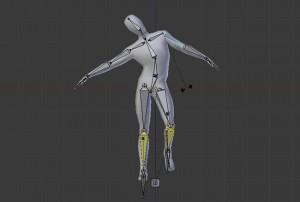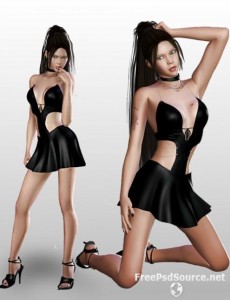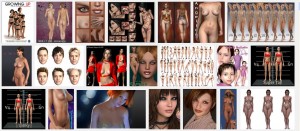One of the criticisms of the original MikuMorphia was that because it looked like a cartoon, it was far from the uncanny. The Uncanny Valley of Computer Graphics appears to be located somewhere between human and inhuman realism – where a 3D render makes the viewer feel uncomfortable because it is almost convincing as a mimetic version of a human, but something feels or appears not quite right. In order to explore this in-between region I therefore had to look towards acquiring or producing more realistic models of humans.
Unity and 3d human-like models
The chosen 3d graphics engine is Unity, and fortunately it is able to import a variety of standard 3d models in a number of formats. Rather than attempting to create a model of a human from scratch I investigated the downloading of free models from a variety of sources including Turbosquid and TF3DM. Many of these models exhibited a reasonable amount of realism, however for the model to work with the Kinect they also need to possess a compatible armature so that the limbs move in response to the actor.

Character illustrating internal armature
Rigging a 3d model with an armature such that the outer skin moves in a realistic manner is a non trivial task, requiring skills and the use of complex 3d modelling tools such as Maya, 3d StudioMax or Blender. I had high hopes for the automated rigging and provided by the online software Mixamo, however the rigging generated proved incompatible with the Kinect requirements.
The astounding Open Source software package MakeHuman enables the generation of an infinite range of human like figures, with sliders to adjust weight, age, sex, skin colouring and enable the subtle alteration of limb lengths and facial features.

This package offers a refreshing alternative to the endless fantasy and game like characters prevalent in human character models on the internet. The generated armature is almost compatible with the kinect requirements such that a figure can mimic the movement of the actor, but due to a lack of one vital element (the root node), the actor has to remain in one position as the virtual character is unable to follow the movement of the actor if they move left or right. I will be investigating the feasibility of adding this additional root node via one of the aforementioned 3d modelling tools.
DAZ3d studio, a free character modelling package does successfully generate characters that possess the correct armature, although the software is free, the characters, clothing and accessories such as hair are all chargeable. However rather than attempting to model characters from scratch this software with its vast library provides a painless and efficient method of generating semi-realistic human-like characters.
Critical Note
I was somewhat surprised by the amount of what can only be termed soft porn available in the form of female 3d models in provocative poses, naked or wearing skimpy clothing; suggesting a strange predominately male user base using the software to create animations and fantasies of a form that objectify women in an adolescent and very non PC manner.
 A google image search of DAZ3d results in a disturbing overview of the genre.
A google image search of DAZ3d results in a disturbing overview of the genre.
